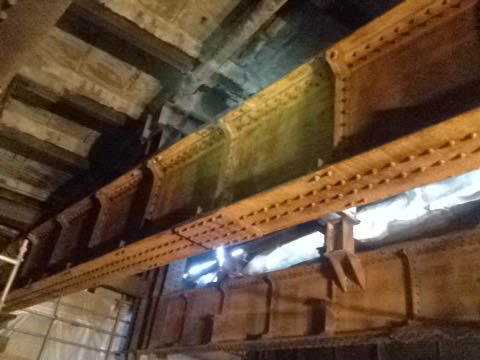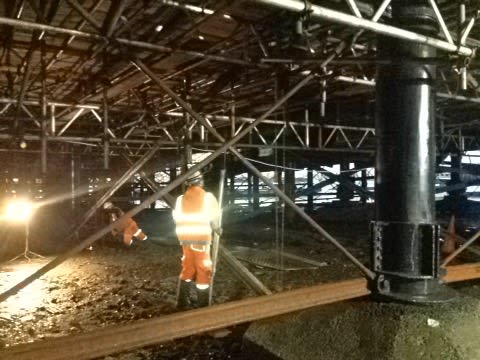- Client: Network Rail
- Lead Contractor: Osborne
- BIM Tools: Autodesk BIM 360 Field/Glue
The ongoing £5.8m project to clean, paint and repair the underside of the pier that supports the platforms for Portsmouth Harbour Station highlights the benefits BIM can bring to small scale projects. It has helped contractor Osborne to manage repetitive tasks, complete work within tidal windows, and visualise a complex structure comprising almost 2,000 separate work items.
The Victorian pier structure extends out over Solent Bay and required extensive refurbishment, due to corrosion caused by rust, including the replacement, repair and repainting of columns, girders, beams, hangers, collars and bracing elements.
Osborne took BIM “into the field” on the project, equipping operatives with tablets to record progress on each work item within the structure, including quality checks and sign offs in real time.
Dominic Lowry, technology improvement manager at Osborne, tells BIM+: “We chose BIM to help us manage the repetitive nature of the job, for example, every column requires high pressure jets to must remove existing paint and rust. It must be cleaned, prepped for repairs, then the actual repair work and repainting is carried out.
“In addition, the 3D visualisation is able to show the precise location of each element within the complicated structure, with the related data attached and easily accessible with the tap of a finger.”
An initial 3D model, based on a laser point cloud survey, was created for Osborne by consultant Masa. The contractor then imported it into the cloud-based collaboration software Autodesk BIM 360 Glue, which hosts the Collaborative Data Environment and enables the model to be viewed on a tablet or a desktop PC. Glue is linked to BIM 360 Field where users input data whilst out on site and it is attached to the model.
Glue enabled Osborne to merge models, run clash detection exercises and perform markups. The software automatically converted all components within the original model into pieces of “equipment”, enabling Osborne to add data and attributes.
“This was much simpler than having to create each one manually,” says Lowry.


The Victorian pier structure extends out over Solent Bay and required extensive refurbishment
Supply chain members are currently using tablets to input job progress into the model. Each of the 1,907 work items is assigned the status “cleaned”, “painted” or “completed”, and quality assurance sheets are filled out electronically and assigned to items as they are carried out.
“BIM has sped up the day-to-day tasks, so when someone is carrying out a QA they haven’t got to go back to the office, find the relevant forms, print them off and fill them out, they simply take out an iPad and begin,” says Lowry.
“The information is readily accessible in the model, where previously it might have been scribbled onto paper then transferred to different forms and folders.”
This efficient process is also helping the team focus on the job at hand and complete work during tight four-hour work windows dictated by the changing tides.
The software enables Osborne to automatically calculate volume measures, a contractual requirement with Network Rail to demonstrate the number of cubic metres of work completed and painted each day.
But the greatest advantage has been the visual clarity provided by the 3D model, says Lowry, allowing suppliers to navigate around it, immediately identify specific components, related notes and photos, then use it to locate the corresponding real components on site.
The model includes detailed information on aspects such as the paint product, expected lifetime, the nature of the repairs and when they were carried out, forming a basic asset model that Network Rail will be able to consult post-completion.
“In 10 years’ time, if any more repair work is required, they can view the model to identify which areas were not addressed by us, or any parts of the original Victorian structure that need further investigation,” says Lowry.
“We are currently waiting to see what format they want the information in. Network Rail has an interest in maintenance information, but they are still formalising their BIM strategy and how they should interface with the supply chain,” he concludes.
BIM has sped up the day-to-day tasks, so when someone is carrying out a QA they haven’t got to go back to the office, find the relevant forms, print them off and fill them out, they simply take out an iPad and begin.– Dominic Lowry, technology improvement manager, Osborne











